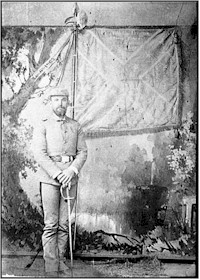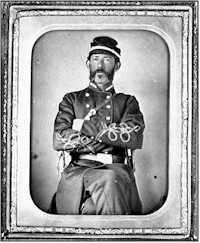
Updated 09/02/2009
![]()

Updated 09/02/2009
![]()
@2009 - Sue Ashby

"They were the first, the fartherest, the last - North Carolina Troops"
On this page you will find bits of information that you may find
interesting,
and hopefully helpful, and links to more.
| Some statistics you may find interesting:
Approximately 16 per cent of all enlisted soldiers during the war
About 30,000 soldiers died in Confederate camps, and about 26,000
The death rate was approximately 13 per cent. The number of men held in camps and not paroled on the field
- information extracted from "Portals to Hell", by Lonnie Speer |
|
Henry Stanley, the famous journalist who travelled across Africa to find Dr. Livington, served in Company E, 6th Arkansas, (what type of service is not in my note) and was a POW who was incarcerated in Camp Douglas, IL. Of conditions in the camp, he said, "We were soon in a fair state of rotting while yet alive." |
Excellent Site!
www.civilwardata.com
| Elmira
How many Southern people know that in the State of New York there are buried 2,917 Confederate soldiers in a cemetery of two and one-half acres that should be inclosed with a fence and memorial gate? In 1864 the United States government located at Elmira N.Y., a prison camp for Confederate soldiers, and until the close of the war it was retained as such, many of the prisoners being transferred from Point Lookout, Md. North Carolina had 1,233 buried there, and South Carolina
|
|
|
|
| Callahan, Jabez, B. 2nd Sgt. Co.
B, 16th N.C. Inf.
Enlisted April 29, 1861, at Marshall, N.C. Appointed drummer Aug. 5, 1861. Sent to ChimborazovHospital #5, Richmond, Va., Dec. 3, 1861 for general debility - diagnosed as enlargement of typhoid gland. Transferred to General Hospital, Dec. 5, 1861. Released to duty Dec 27, 1861. Wounded at Battle of Fredericksburg, VA., Dec. 13, 1862. Made Roll of Honor. In hospital in Lynchburg, Oct. 11, 1863 until after Oct. 31, 1863 (I don't know why). Appointed 2nd SGT. March 22, 1864. Captured at Battle of Plank Road (Wilderness, Va.), May 6, 1864. Taken to Belle Plain, Va., sent to Point Lookout, Md. prison May 17, 1864 then to Elmira, New York prison Aug. 10, 1864. Released June 22, 1865 Hutchinson, A. J. Co. A, 30th N.C. Inf.
Hutchison, David Washington Hutchison
Johnson, William M. Henry Co. K, 52nd N.C. Reg.
Saunders, Robert James Co. H, 5th NCV
Stephenson, Benjamin T. 32nd N.C. Vol.
Tunstall, Jerome B.V. 23rd N.C. Vol.
Vann, Chester R. Co. K, 51st N.C. Reg.
Warren, James C. Co. I, 51st N.C. Reg.
Williford, Richard W. Co. K, 51st N.C. Reg.
Henry Philip RUDISILL, 1st Lt. Co. A, 12th NC
Jacob F. RUDISILL, Corp. Co E, 32nd NC
Polycarp C. RUDISILL, Pvt., Co. E, 32nd NC
Alfred Solomon CARPENTER, Sgt., Co. B, 23rd NC.
James Dennis IJAMES, Sgt. Co. F, 13th NC
Matthew Newberry IJAMES, Corp, Co. F, 13th NC,
Joseph Eli MILLER, Pvt. Co C, 57th NC.
Miles Alfred YOUNT, 1st Lt., Co. A, 12th NC,
Elcanah YOUNT, Pvt. Co A, 12th NC
John Hosea YOUNT, Pvt. Co A, 12th NC
MEDLIN, Garrison Boswell, Pvt., Confederate, Co. D, 37th NC Infantry
Regiment,
Pvt. Hugh Kerr ROBERTS, 14th NC Infantry, NCST Co. D.
Private Edward Parrish, Company I, 6th North Carolina Infantry Regiment.
There is a Corp James Batchelor buried in the Confederate Cemetery
at Pt
I just wanted to let you know that there was a William Love from
the 61st
F. Hope, Pvt. Co. A. 49th Regt. NC
H. B. Hope Pvt. Co. E. 43 Regt. NC
William Eli Wallace b. abt 1844/45 NC. D. 1882 Postoak, Jack Co.
TX
|
|
 |
Portrait of Capt. James R. Love, Company A, 16th North Carolina Regiment, C.S.A. |
|
Portrait
of Lt. Col. James T. Weaver, 60th North Carolina Regiment, C.S.A.
|
 |
| This is an interesting story about how a group of Union
prisoners at Libby Prison, who were marked for execution in retaliation
for the deaths of three other men were ransomed by the exchange of a general
who had been captured by some Pensylvania soldiers...another interesting
light on what it meant to be a POW...
http://208.242.114.247/11-PA-Cav/articles/fh_lee.htm |
| These are some statistics on some of the most notorious
prison camps. Not all camps were this bad, by the way, but these were among
the worst.
Camp Douglas, IL (USA) - used as a POW camp from 62-65. Was designed with a max capacity for 6000 men, but during its most crowded they managed to cram in over 12,000. Almost 4500 people died here. Salisbury, NC (CSA) Designed for 2,000. At one point, over 10,000 people were jammed into it. It was used from 61-65. Elmira, NY (USA) Its capacity was designed for 5000, but at one point they managed to get over 9400 people into it. Although they only used it for two years, just under 3,000 people died here. Andersonville, GA (CSA), the most notorious of all of the prison
camps.
Point Lookout, MD (USA) During the three years it was used, 3,500 men died here. At its most crowded, it held about twice its design capability, topping off at 22,000 at its most dense. Danville, VA (CSA) Designed for 3700, at its most croweded, they put 4000 men in here. Used from '63-'65, just under 1300 men died here. Camp Morton, IN (USA) Set up for 2000, it reached a maximum of 5000 POWs. Used from '62 - '65, around 1700 deaths were recorded. |
|
EXPERIENCE OF A CONFEDERATE SOLDIER IN CAMP AND
18th Georgia Infantry Home Page has an account of the
|

|
During the War Between the States, 193,750 Union and 215,000 Confederate soldiers, sailors, and Marines became prisoners of war (POW). More than 30,000 Union and 26,000 Confederate prisoners died in captivity (which equals 12% in the North and 15.5% in the South). There should have been a much greater disparity in death rates between Northern and Southern POW camps. There was a far superior supply of physicians, hospitals, medicines, and food available in the North than in the blockaded and starving Confederacy, therefore Union camps should have experienced a much lower death rate than they did. Northern attitudes towards Southern prisoners, often manifested in deliberate maltreatment, contributed towards the unnecessarily high death rates of Confederate prisoners confined in Union prisons.
UNION PRISON CAMPS (1861 - 1865) Alton (IL) Military Prison, 1861-1865. First Illinois state prison, built in the 1850s and denounced by Dorothea
Dix as unhygienic.
Camp Chase (OH) Military Prison, 1861-1865. Training camp west of Columbus, converted to a prison camp. About 8,000 prisoners in mid-1863. One captive officer described the place as being so filthy that no self-respecting Tennessee farmer would house his pigs there. Fort Delaware (DE) Military Prison, 1862-1865. Located on an island in the Delaware River (and perhaps the prison most dreaded by Confederate troops. Camp Douglas (IL) Military Prison, 1862-1865. First Federal training camp (built on property that belonged to Sen. Stephen A. Douglas, who was also a property speculator); established south of Chicago, 60 A. in area, converted to a prison camp after the fall of Ft. Donelson in Feb 1862. One-story wooden barracks for 125-150 men each. Post hospital for Union troops serving as guards and tent wards for the prisoners. A large fire destroyed many of the barracks Nov 1863 and some prisoners were transferred to Rock Island. Total of about 30,000 prisoners; high point was Dec 1864, with more than 12,000 names on the roll. At least 4,450 of who died (a death rate of 9%). Most are buried in the "Confederate Mound" in Oakwood Cemetery, Chicago. About 500 successful escapes. Dismantled Nov 1865. Elmira (NY) Military Prison, 1864-1865. Created in May 1864 as a transfer depot by enclosing a 30 A. site with
existing barracks on the Chemung River near Elmira, and was known in the
South as "Hell-mira." There were 35 barracks (two-story, low-ceilinged,
with unsealed roofs and floors) which held only half the 10,000 prisoners
(enlisted men only); the rest lived in tents or slept in the open, even
in the worst winter weather. Clothing and supplies sent from the South
was warehoused by the Commandant and not distributed for up to six months;
food *donated* by local churches was *sold* to the prisoners by corrupt
Union officers. Many prisoners were transferred there from Point Lookout.
Broiled rat was regarded as a delicacy and any dog that wandered within
reach was quickly slaughtered and consumed (a punishable offense). One-acre
lagoon of stagnant river water within the compound served as a latrine
and dump, and led to large epidemics. Most guard detachments were recruited
ex-slaves. More than 10% had no blankets; food was scarce and usually spoiled.
Scurvy was common. The Commandant refused to "waste" medicines on prisoners
and also barred
Gratiot & Myrtle Streets Prison (St. Louis, MO), 1862-1865. Held POWs, Union army deserters, bounty jumpers, bushwhackers, accused spies, and civilians accused of "disloyalty" (who were held without habeas corpus). Originally a medical college, it could safely hold about 500 men but more than 1,000 were confined there at all times. Prisoners set the building on fire twice and many tried to escape by tunneling or by attacking the guards. Johnson's Island (OH) Military Prison, 1862-1865. Located in Sandusky Bay, Lake Erie; construction was completed Feb 1862.
First prisoners (of all types) arrived April 1862; officers were later
separated out and sent to the Island, which became virtually an officers'
and civilian prison. During its 40 months of operation, at least 12,000
CSA officers were held there -- including Isaac Trimble, Henry Kyd Douglas,
Charles Olmstead, John Marmaduke, Jeff Thompson, and Basil Duke. Shelter
was 13 two-story barracks intended to hold 3,250 prisoners; by April 1865
there were about 3,000 prisoners. Water supply was adequate at first but
drainage was very poor and fresh water finally became almost nonexistent.
General health conditions were above average, however, compared to other
Federal prisons; a total of 221 men died out of approx. 12,000 total prisoners.
Post commanders were drawn from Sandusky itself and were usually well enough
liked. Clothing was adequate but most prisoners were unprepared for the
severity of the winter weather. Food rations were adequate and additional
supplies could be purchased -- until spring 1864, when rations were sharply
reduced and supplemental purchases curtailed, apparently in reaction to
atrocity stories circulating in the North rather than to lack of supplies.
Since the Island was separated from the mainland by 1/2 mile of water (or
ice), there were few escape attempts; only 12 men escaped to Canada, and
there was one unsuccessful attempt by Ohio Copperheads to capture and liberate
the prison. No trace of the facilities is left today except a one-acre
cemetery and the Island
Camp Morton (IN) Military Prison, 1862-1865. Located on the state fair grounds in Indianapolis; unfloored barracks
within an enclosure.
Old Capitol Prison (Washington, DC), 1863-1865. Temporary building constructed c1815 after the British burned the U.S. Capitol in the War of 1812; later used as a hotel and became dilapidated and dangerously run down. Held POWs, Union deserters, suspected spies, and miscellaneous prisoners awaiting trial. Point Lookout (MD) Military Prison, 1863-1865. Large tent camp with no barracks, set up where the Potomac runs into
Chesapeake Bay.
Rock Island Barracks (IL) Military Prison, 1863-1865. Union's westernmost POW camp, located on an island in the Mississippi between Rock Island, IL and Davenport, IA. Originally the site of Ft. Armstrong (1816-36); after the War, it became the permanent site of the Rock Island Arsenal. Ordered to be built in July 1863 but still not completed when about 5,000 prisoners arrived in December. From then until the end of the War, there were 5,000 to 8,000 prisoners at all times. High fence enclosed 84 barracks, each with its own cookhouse. Adequate clothing and usually adequate food rations, but water was scarce and occasionally nonexistent. Major outbreaks of smallpox from the beginning; inadequate medical care and no hospital ward. Prisoner labor constructed sewers and a waterworks (for which they were paid a small amount on the sutler's account books). Several small but successful escape attempts in mid-1864. Many prisoners took the Oath in Dec 1863 and were "galvanized" into the Union army to fight Indians; loyal Confederates resisted this by reenlisting their own men (whose terms of enlistment had expired while they were imprisoned). Conditions deteriorated in late 1864 and local newspapers began editorially comparing Rock Island to Andersonville (two editors who did so were arrested and imprisoned by Federal authorities for disloyalty and sedition). During the 20 months it operated, Rock Island held a total of 12,400 prisoners; 1,960 died in confinement, 41 escaped, 5,580 were paroled home, and approx. 4,000 enlisted in the Union army. About 200 civilian political prisoners from Missouri also were housed there late in the War. Prison barracks were empty by July 1865 and served as ordnance barracks for the Arsenal until 1909. Confederate and National Cemeteries are still maintained there. Fort Warren (MA) Military Prison, 1861-1866. Built in Boston harbor as part of the city's seaward defenses in the
early 19th century. Served first as a training base for several Massachusetts
regiments -- who complained bitterly about *their* inadequate housing and
food. First CSA prisoners arrived in Oct 1861, including Southern political
prisoners (who were arrested and held without charges being preferred against
them). Overcrowded and undersupplied from the first. Officers had limited
parole on the island outside the fort itself. Boston newspapers of both
political parties tried to raise food, blankets, etc, for the prisoners;
other papers (including Garrison's THE LIBERATOR) argued that "traitors
should receive nothing" and should be allowed to starve (this attitude
became a local election issue in Boston). Prisoners did their own cooking
in large, unsheltered boiling pots and kettles. Enlisted men and political
prisoners received much worse housing than officers. Prisoners raised the
ire of their jailers by singing Southern patriotic songs (quickly forbidden)
and holding a mock trial of Sec. of War Seward (he was found guilty of
having "abolished the Constitution"). Confederate generals Buckner and
Tilghman were housed there for 6 months until exchanged. Many Ft. Donelson
prisoners ended up there, as well as CSA naval personnel. By late 1862,
the small rations of bread, soup, and hominy meant that most prisoners
were hungry all the time.
|
Brothers Bound: A Source Page for CW Era Prisoners of War
http://homepages.rootsweb.com/~south1/bound.htm
Andersonville Prisoner Database
has the name of 32,000 prisoners who were at Andersonville
http://www.corinthian.net/mccc/plookup.htm